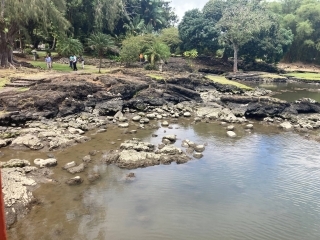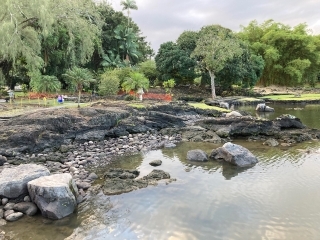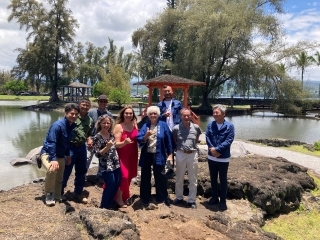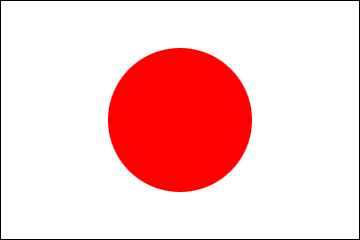Consulate Activities
2022/6/8
Japanese Landscape Architects Restore Japanese Garden at Lili’uokalani Park in Hilo, Hawaii
The Japanese Garden at Lili’uokalani Park in Hilo on the Big Island of Hawaii has been selected for the “Overseas Japanese Garden Restoration Project” and four landscape architects from Japan have been working on the restoration. This project is sponsored by the Government of Japan’s Ministry of Land, Infrastructure, Transport and Tourism (MLIT), which has been supporting the restoration of Japanese gardens around the world since fiscal year 2009. Restoring Japanese gardens worldwide showcases the charm of Japanese culture worldwide, thereby helping to promote tourism to Japan as well as the development of landscaping and greening technology abroad.
The restoration of the Japanese Garden at Lili’uokalani Park in Hawaii has been selected to help strengthen the Japan-U.S. relations at the grassroots level. The restoration was originally scheduled to take place in 2020, but it has finally come to fruition after it was postponed due to the coronavirus pandemic.
Overview of the restoration of Lili’uokalani Park
The 1960 tsunami washed mud into the pond that occupies a large portion of the garden. Although organizations and volunteers have been working continuously to restore the pond by removing the mud, it is still damaged in many places. Since the garden is adjacent to the coast, it was necessary to work during low tides because the tides would affect the restoration work.
Restoration Period
Friday, June 3, 2022 to Tuesday, June 7, 2022
Landscape architects from Japan
Mr. Hiroshi Terashita (Shiga Prefecture) :Master landscaper
Mr. Yasumasa Imada (Kagawa Prefecture):Leader
Mr. Takahiro Senuma (Tokyo)
Mr. Taiki Saito (Nagano Prefecture)
Outline of Lili’uokalani Park
Lili’uokalani Park opened in Hilo, Hawaii in 1919. Queen Liliuokalani, the eighth and last monarch of the Kingdom of Hawaii, donated the land to the government. The Japanese Garden, which occupies a large portion of the park, was constructed between 1917 and 1919. The park features a pine tree planted by Hitachinomiya Imperial Prince Masahito, the "Matsunami An" tea ceremony house donated by Dr. Sen Genshitsu, Daisosho (former Urasenke Grand Master) of the Japanese tea ceremony (chado), and a collection of gifts from 14 Japanese prefectures including Okinawa and Hiroshima to commemorate the 100th anniversary of the government's immigration to Hawaii.
The restoration of the Japanese Garden at Lili’uokalani Park in Hawaii has been selected to help strengthen the Japan-U.S. relations at the grassroots level. The restoration was originally scheduled to take place in 2020, but it has finally come to fruition after it was postponed due to the coronavirus pandemic.
Overview of the restoration of Lili’uokalani Park
The 1960 tsunami washed mud into the pond that occupies a large portion of the garden. Although organizations and volunteers have been working continuously to restore the pond by removing the mud, it is still damaged in many places. Since the garden is adjacent to the coast, it was necessary to work during low tides because the tides would affect the restoration work.
Restoration Period
Friday, June 3, 2022 to Tuesday, June 7, 2022
Landscape architects from Japan
Mr. Hiroshi Terashita (Shiga Prefecture) :Master landscaper
Mr. Yasumasa Imada (Kagawa Prefecture):Leader
Mr. Takahiro Senuma (Tokyo)
Mr. Taiki Saito (Nagano Prefecture)
Outline of Lili’uokalani Park
Lili’uokalani Park opened in Hilo, Hawaii in 1919. Queen Liliuokalani, the eighth and last monarch of the Kingdom of Hawaii, donated the land to the government. The Japanese Garden, which occupies a large portion of the park, was constructed between 1917 and 1919. The park features a pine tree planted by Hitachinomiya Imperial Prince Masahito, the "Matsunami An" tea ceremony house donated by Dr. Sen Genshitsu, Daisosho (former Urasenke Grand Master) of the Japanese tea ceremony (chado), and a collection of gifts from 14 Japanese prefectures including Okinawa and Hiroshima to commemorate the 100th anniversary of the government's immigration to Hawaii.
 Before
Before
 After
After
 Japanese landscapers and Friends of Lili'uokalani Gardens committee members
Japanese landscapers and Friends of Lili'uokalani Gardens committee members
